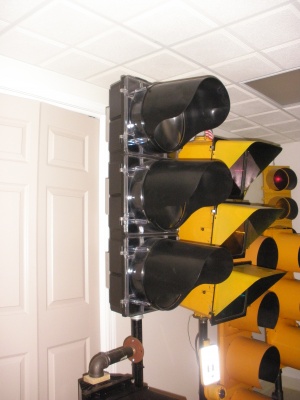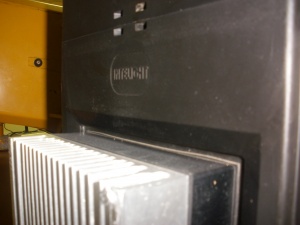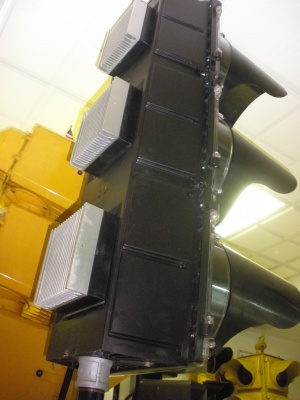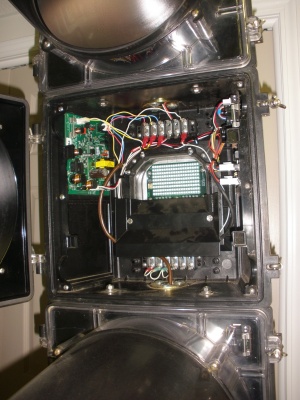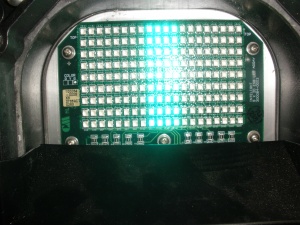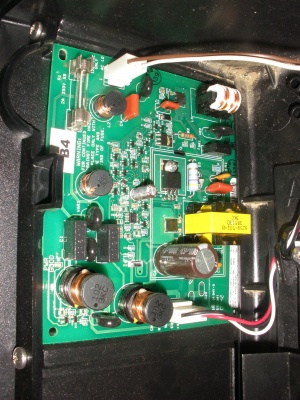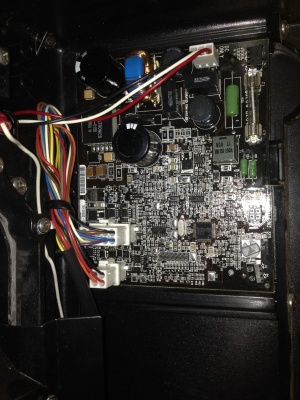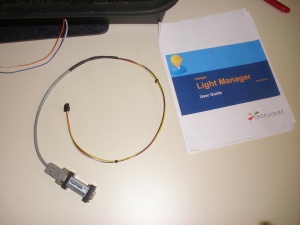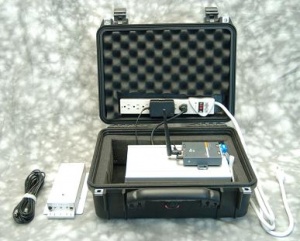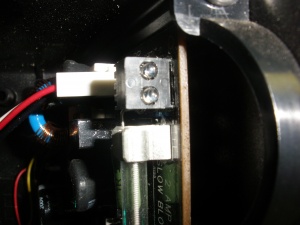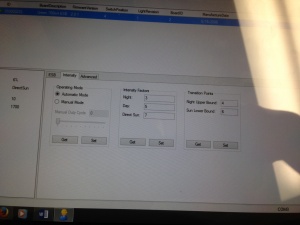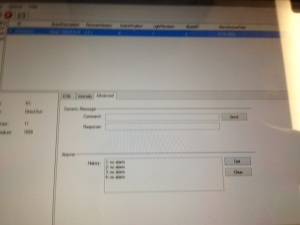Intelight
Contents
Introduction
Intelight’s flagship traffic signal product is their Electronically Steerable Beam (ESB) programmable visibility signal head. Essentially a modified version of the Optisoft vehicle signal, the Intelight model is advertised to compete with legacy incandescent programmable vehicle heads such as those made by 3M and McCain.
Physical Features
The ESB uses a Fresnel diffusing lens with a bank of LEDs (herein known as the “array”) behind to provide the illumination of the indication. The array has 9 rows and 20 columns of a single color of LED per section. The array circuit board is mounted directly to an aluminum heat sink to dissipate heat to outside the signal, improving the life of the electronics in the signal.
The housing is made of flame retardant Makrolon 9417, a type of high-grade polycarbonate, and available in the standard traffic signal colors. The housing is designed to be roomy, and house various electronics for a variety of options. Each section has four molded bosses where circuit boards could be installed.
The door is a one piece molded part, which eliminates the need for a lens gasket. The door is molded transparent and everything is blanked out, excluding the dome and ambient sensor window, with a molded plastic backing held in with the lens hardware
The lens is a milky, clear Fresnel, “diffuser” type that sits immediately behind the clear outer dome of the one-piece door. The lens is designed to disperse light across the entire dome, while not allowing any individual LED points be visible from the roadway. Intelight also offers a colored lens option in place of the standard clear lens.
The interior of each section of the ESB typically houses two main circuit boards in addition to the array for standard operation: a power filter circuit board, and a CPU controller board.
The power filter board does exactly that, it filters in power from the field to turn the LED array on at low voltage. It operates at both 120 volt AC and 48 volt DC power sources, and will indicate on the board that it is receiving power and operating properly.
The CPU controller board (herein as the CPU board) acts as the brain for the section. It handles the electronic steering of the light, ambient light adjustment, and stores general information about the section it controls. All of which can be accessed remotely using Intelight’s programming kits and software.
Standard Operation
The main selling feature of this signal is its ability to be programmed electronically, without tape, and in half the time compared to legacy programmable heads. Light steering can be done in the horizontal and vertical directions by effectively shutting off rows and columns of LEDs in the array, narrowing the light beam. Steering is achieved using either the wireless kit, or a serial interface kit. Both kits use Intelight’s Windows based interface software, "Light Manager". Light Manager comes in two main configurations: a laptop/tablet version, and mobile smartphone version.
When then array in a particular section is lit, the CPU board is recording general information about the light and the electronics. This is indicated by a flashing green indicator on the CPU. This data can be accessed by Light Manager when registering the signal at the time the array is on. Light Manager can only see and access the section when the light in that section is on.
Electronic Steering and Kits
As stated, two configurations are available to interface with the ESB. The more common version is the wireless kit, which uses a radio that is connected to a special load switch and talks over WIFI to the modem in the signal head. Once the radio equipment and load switch are set up, the technician simply stands where the masking point will be and select it via smart phone. This special load switch is only used to program, and once set can be replaced with a standard load switch. The other version is not typically used for field steering, but is available for shop environments and similar instances. It is the serial kit, which interfaces directly between the CPU board and a laptop or tablet.
When the light is on and has been registered in order to exchange data with Light Manager, the screen will display all the general information about the light including numeric ID, color, current, and manufacture date. The software can then access the current array configuration and it can be adjusted in real time in two row, or two column increments.
The software can only change or update the signal when the light is on, and has been registered in the software. When the light is off the software no longer can access the information but the software knows there is a registered array out there. This poses a problem with steering the yellow section. There are two ways to overcome this issue: one is to place the intersection in stop time to gain a few extra minutes to fine tune the yellows, or two, use the manual set feature in Light Manager so that changes are not completed in real time. The registered array can be set up while the light is not active, then immediately when the light comes on, send all the changed data manually.
Ambient Light Adjustment
The ESB also incorporates an infrared sensor, placed behind a window in the door, which automatically adjusts the intensity of the LEDs based on outside conditions. This sensor differs from those used in 3M or McCain heads, as it is logic based, with three internal levels: day, night, and direct sun, to a numeric value. When the CPU sees the values within a certain range, it will translate that info into a setting level.
The sensor is active by default, but can be disabled in Light Manager. Values for the different level setting can be adjusted, and there is an option to manually select an intensity level from 0 (off), to 100 (full power)
Other Features
In addition to all the features mentioned, the ESB also stores alarm information at the time the light is on. These alarms can also be accessed through Light Manager, and typically come up if there are issues with the electronics, or if the LED array is failing. If everything is operating properly, accessing the alarms from the signal will simply show “NO ALARM” from the screen. Up to four alarm conditions can be stored per section.
Intelight offers a built in video camera and electronics package that can be installed in the head for traffic surveillance. This feature is largely a carry over from the Optisoft days and is typically not selected. The camera installs in the lower left hand corner of the door, where another window must be punched out for it.
Update: As of 2014, the built in video camera option is no longer offered.
The other homeland security sensor options from Optisoft have largely been discontinued in one way or another.
Misc. Information
2013-2014: Intelight redesigned the wireless programming kit after the third party supplier discontinued equipment used in it.
As of 2014, the built in video camera option is no longer offered and a very limited stock remained
2015: Intelight discontinued the electronically steerable beam signal to move forward with the controller and software markets.
